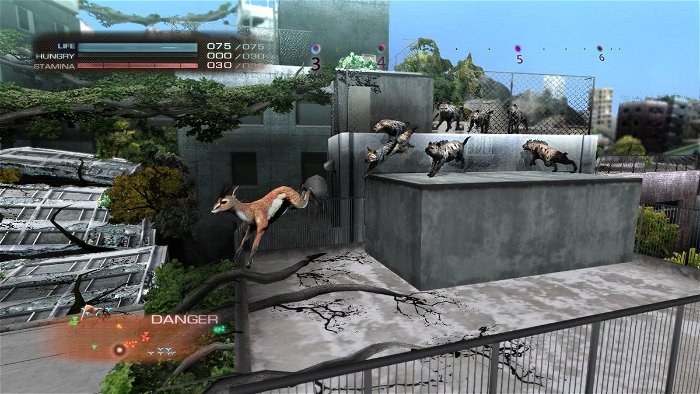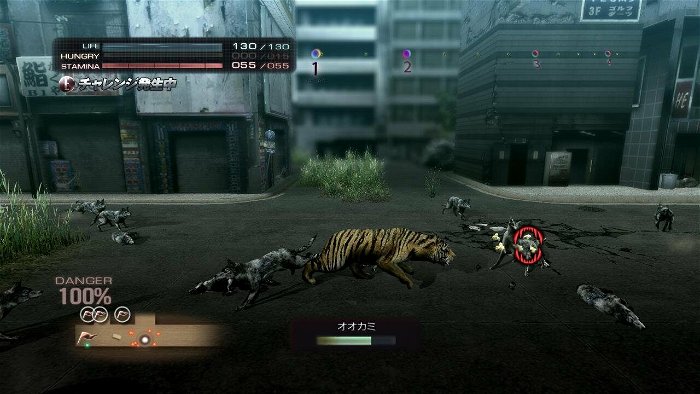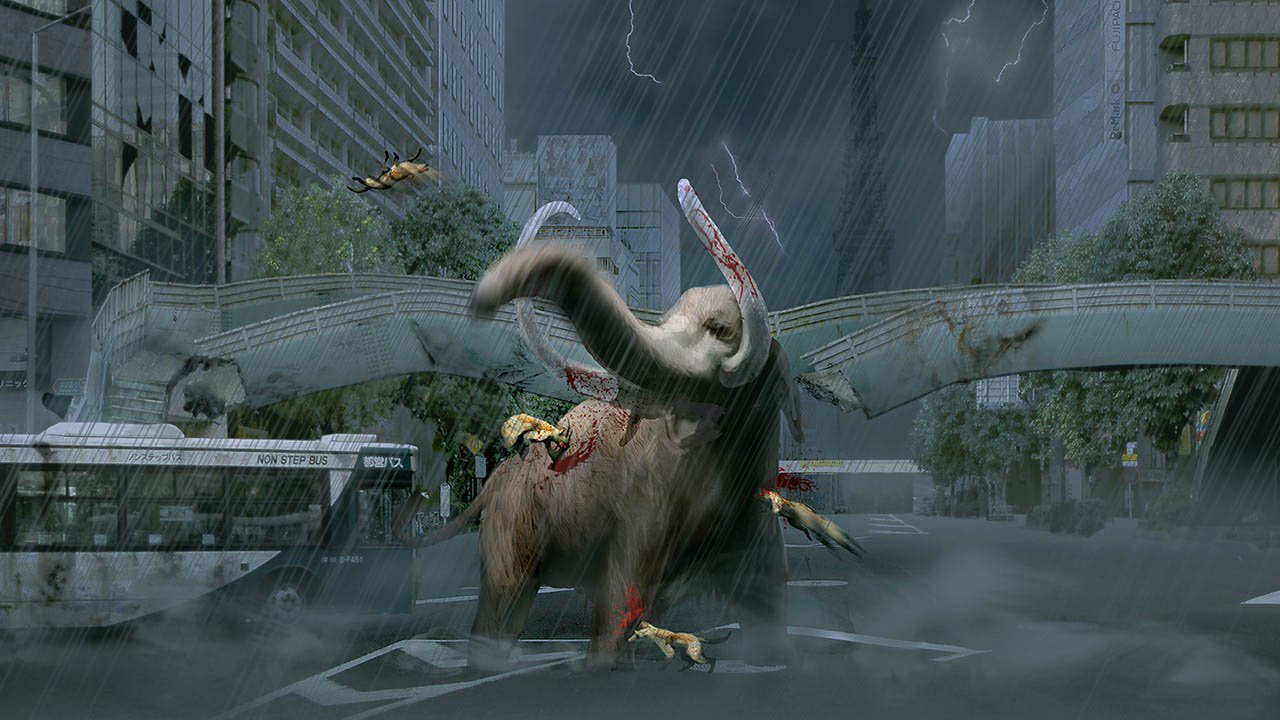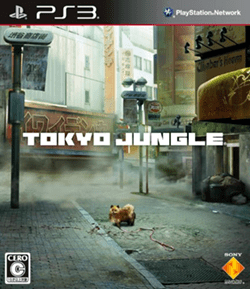1) When I was six or seven years old one of my older brothers pushed me into a snowbank while we were playing outside. I laughed and lay still and he threw shovels of snow onto me until I was buried. Our dog, a yellow lab, came up on top of where I was covered and, whimpering frantically, dug me out, licking my face with crazed relief after she had “freed me.” She would also, sometimes, strain her leash and go nearly mad with fury, growling, if she spotted a squirrel or possum while out on a walk.
2) If my current pet, an overweight black and grey tabby cat, was to find me and my partner dying alone on the floor of our apartment she would probably not try to help us. It’s apparently common for housecats to eat their owners if they cannot find another source of food as well. Aside from this, she cries herself hoarse if left alone overnight and purrs like a maniac when she’s being pet or held by one of us.
Tokyo Jungle is a game based on the more cynical facets of pet ownership. It takes our anthropomorphic view of animals and turns it on its head, centering on the domestic cat that would eat its human master if starving or the loving dog that goes insane with primal bloodlust when a weaker animal is within its sight. None of this is to say that the game takes this viewpoint in order to make us question modern views on animal “ownership” in any serious manner. Instead, it points out the hilarious absurdity of keeping wild creatures in our houses and apartments —neutering, spaying, muzzling and dressing in little coats — when, really, non-human animals are meant to be spending their time killing, mating and fighting over territory.
It accomplishes this through a simple premise. In Tokyo Jungle humanity has mysteriously vanished and the previously bustling streets of the Japanese capitol are now empty except for the animals that were previously confined to homes and zoos. Players are tossed into the game without any explanation as to what befell Tokyo and, by collecting “Archive” notes (small excepts from pre-disaster newspaper reports, diaries, etc.), come to uncover what turns out to be a fantastically absurd spin on post-apocalyptic genre conventions.

Two different modes make up the bulk of the game: Survival and Story. Most of the player’s time is spent in Survival, a style of play that focuses on, like the name suggests, simply living as long as possible. Players choose their animal before beginning (initially only a carnivorous Pomeranian and an herbivorous deer are available while others are unlocked by completing animal-specific challenges) then set out into the human-free Tokyo to make their way. The basic goal of Survival mode is to eat (carnivores consume other animals while herbivores must locate plants), take over neighbourhoods by marking specific areas (pressing circle at a flag) and mating in order to carry on through future generations.
While trying to achieve these goals players must keep an eye on a constantly draining hunger gauge. Drinking water temporarily fills it, but eating plants or animals does the same while also providing calories and levelling up the animal, increasing the size of its life bar and boosting attack and defence values. These stats become more and more important the longer the animal lives. Breeding and producing packs helps provide a buffer against the increasingly vicious enemies that populate the remote neighbourhoods of Tokyo that have to be explored in order to find new food sources and mates. Rolling around the streets with a pack also provides a kind of continue — if the player dies they assume the role of another member of their family — that makes surviving for decades possible.

A given run through Survival can range from 20 minutes to one or two hours, depending on how successfully the player is able to negotiate the various threats of the city. Jungle has been designed with these shorter play times in mind, its difficulty ramping up considerably as time goes on and bad luck cutting a run through short in a way that resembles the ruthlessness of roguelike titles. The save system on offer functions like a single, temporary checkpoint, recording progress at specific junctures, but being automatically replaced as soon as the game is resumed.
This lack of persistence — and an emphasis on completing challenges that provide “Survival points” used for unlocking equipment and new animals — means that Jungle is meant to be returned to often. A design centred on nearly infinite replayability works in the game’s favour, the ability to try out new animals (I still have a long, long way to go before unlocking one of the dinosaurs) and a wide array of challenges providing plenty of incentive to re-enter the concrete jungle again and again.
Tokyo Jungle’s Story mode is a simpler, more directed take on Survival, concentrating on achieving specific goals as pre-determined animals while fleshing out the backstory drip-fed through Survival’s collectible notes. Unlike many other games, the pick-up-and-play of Survival represents the primary focus of the experience while the Story mode serves as a supplement. Neither Story nor the game’s (local) two player Survival option make for substantial additions to the game, but they’re both still welcome distractions that serve to mix up the repetition of working toward unlocking new animals and earning points in Tokyo Jungle’s primary mode.

Rough presentation — flat textures and a fairly uninspired soundtrack, consisting of short, highly repetitive little dance beats — doesn’t do too much to get in the way of everything that the game does right, but some instances of poor level design lead to a few too many headaches. Running from one end of Tokyo to another and accidentally taking a wrong turn through Shibuya’s maze of devastated apartments when an objective timer is counting down toward failure can be immensely frustrating.
The choice to develop the game using a pseudo-2D viewpoint can make navigating three dimensional structures a challenge, a problem that isn’t helped by the simplicity of the menu screen’s marginally detailed map. While it may seem like a minor complaint, the frequent annoyance caused by this problem becomes noticeable in Tokyo Jungle’s relatively small playing area. It’s a shame that an issue like this — an issue that actually made me feel at times discouraged from jumping into yet another round of the otherwise addictively enjoyable Survival mode — gets in the way of the pure fun offered by most of the game.
Despite quibbles like these, a solid set of mechanics and the powerful enticement of an enormous number of animals and items to work toward unlocking makes Tokyo Jungle fairly easy to recommend. That it delivers on its enormously unique premise through gameplay mechanics that truly explore the idea of a world run by animals (albeit with a nearly constant smirk) is the real testament to what Tokyo Jungle offers. Anyone whose interest is piqued by the setting alone — or anyone who ever wondered exactly what their pet’s life would look like without any humans to get in the way — will find a whole lot to like here.






